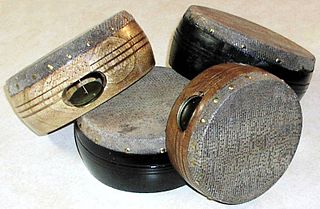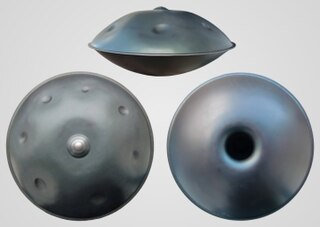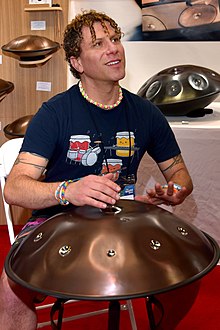
A percussion instrument is a musical instrument that is sounded by being struck or scraped by a beater including attached or enclosed beaters or rattles struck, scraped or rubbed by hand or struck against another similar instrument. Excluding zoomusicological instruments and the human voice, the percussion family is believed to include the oldest musical instruments. In spite of being a very common term to designate instruments, and to relate them to their players, the percussionists, percussion is not a systematic classificatory category of instruments, as described by the scientific field of organology. It is shown below that percussion instruments may belong to the organological classes of idiophone, membranophone, aerophone and chordophone.
The music of Trinidad and Tobago is best known for its calypso music, soca music, chutney music, and steelpan. Calypso's internationally noted performances in the 1950s from native artists such as Lord Melody, Lord Kitchener and Mighty Sparrow. The art form was most popularised at that time by Harry Belafonte. Along with folk songs and African- and Indian-based classical forms, cross-cultural interactions have produced other indigenous forms of music including soca, rapso, parang, chutney, and other derivative and fusion styles. There are also local communities which practice and experiment with international classical and pop music, often fusing them with local steelpan instruments.

The steelpan is a musical instrument originating in Trinidad and Tobago. Steelpan musicians are called pannists.

The pedal steel guitar is a console-type of steel guitar with pedals and knee levers that change the pitch of certain strings to enable playing more varied and complex music than other steel guitar designs. Like all steel guitars, it can play unlimited glissandi and deep vibrati—characteristics it shares with the human voice. Pedal steel is most commonly associated with Country music and Hawaiian music.

The ghaṭam is a percussion instrument used in various repertoires across the Indian subcontinent, especially in Southern India. Its variant is played in Punjab and known as gharha as it is a part of Punjabi folk traditions. Its analogue in Rajasthan is known as the madga and pani mataqa.

The mridangam is a percussion instrument originating from the Indian subcontinent. It is the primary rhythmic accompaniment in a Carnatic music ensemble. In Dhrupad, a modified version, the pakhawaj, is the primary percussion instrument. A related instrument is the Kendang, played in Maritime Southeast Asia. Its a complex instrument to tune and involves a lot of mathematics to construct korvais.
The music of Bermuda is often treated as part of the Caribbean music area. Its musical output includes pop singer Heather Nova, and her brother Mishka. Collie Buddz has also gained international success with reggae hits in the US and the UK.

The music of Saint Kitts and Nevis is known for a number of musical celebrations including Carnival. The last week in June features the St Kitts Music Festival, while the week-long Culturama on Nevis lasts from the end of July into early August.

The kanjira, khanjira, khanjiri or ganjira, a South Indian frame drum, is an instrument of the tambourine family. As a folk and bhajan instrument, it has been used in the Indian subcontinent for many centuries.
D'Addario is a family-owned and operated American multinational company that specializes in musical instrument accessories, headquartered in Farmingdale, Long Island, New York.

A folk instrument is a traditional musical instrument that has remained largely restricted to traditional folk music, and is not usually used in the classical music or other elite and formal musical genres of the culture concerned, though related intruments may be.

The Hang is a type of musical instrument called a handpan, fitting into the idiophone class and based on the Caribbean steelpan instrument. It was created by Felix Rohner and Sabina Schärer in Bern, Switzerland. The name of their company is PANArt Hangbau AG. The Hang is sometimes referred to as a hang drum, but the inventors consider this a misnomer and strongly discourage its use.

Elliott Anthony "Ellie" Mannette[a] was a Trinidadian musical instrument maker and steel pan musician, also known as the "father of the modern steel drum".
Electromuse was an American maker of musical instruments that operated in the 1940s and 1950s.
Bertram Lloyd Marshall ORTT, known as Bertie Marshall, was a pioneer, musician and music instrument maker of the steelpan.
The Trinidad All-Steel Pan Percussion Orchestra (TASPO) was formed to participate in the Festival of Britain in 1951. The group was the first steelband to travel abroad from Trinidad and Tobago, presenting the newly invented steelpan to an international audience.
Rudolph Charles was a musician and instrument maker of the steelpan, but most notably, he was a pioneer and leader of the steelband movement in Trinidad and Tobago. Also known as Charlo, The Hammer and Trail, among other names, he led Desperadoes Steel Orchestra to 10 various victories from 1965 to 1985, including six Panoramas, two Classical Music Festivals, one Best Bomb and one Best Playing Steel Orchestra.

Repurposing is the process by which an object with one use value is transformed or redeployed as an object with an alternative use value.

A steel tongue drum, tank drum, or hank drum is a round steel slit/tongue drum in the idiophone family originally fashioned from a propane cylinder.

The Gubal is a musical instrument developed by the Swiss company PANArt Hang Manufacturing Ltd.. It is a vessel made of PANArt's patented Pang, a deep drawn sheet steel permeated by iron nitride needles. Pang was developed by PANArt for steelpan construction in the middle of the 1990s. Examining the characteristics of their new material the PANArt tuners Sabina Schärer and Felix Rohner created a number of different Pang instruments. In the year 2001 they introduced the Hang. The Gubal was the first Pang instrument that was developed after the Hang. It was introduced in Summer 2013 on occasion of the 20th anniversary of PANArt. The name Gubal is registered as trademark for musical instruments by PANArt Hang Manufacturing Ltd.















